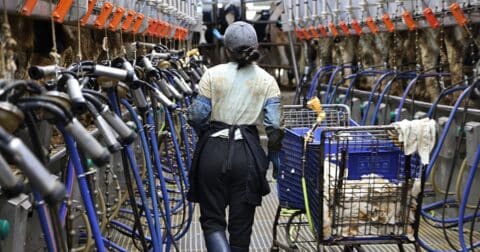Feature
High-Protein Diets Are Popular — but They Certainly Aren’t Sustainable
Diet•9 min read
Analysis
Human cases remain rare but the risk of an outbreak could change at any time.


Words by Jenny Splitter
There are now 67 human cases of avian flu in the United States, including one fatality in Louisiana, according to the U.S. Centers for Disease Control and Prevention. The patient, who was over 65 and suffered from underlying health conditions, had been exposed to both wild and backyard poultry birds.
There are 38 cases in dairy farm workers in California, where Governor Gavin Newsom has now declared a state of emergency. In Colorado, there are 10 cases, mostly in poultry farm workers, and also Washington, where there are 11 infected poultry workers. Avian flu has now been detected in commercial flocks in Georgia, the leading producer of broiler chickens, where previously it had been limited to backyard farms.
The disease initially proliferated in wild bird populations at more than 10,000 cases, but spread to wild mammals, as cases were found in foxes, otters, sea lions and bears. In farm animals, avian flu has spread not only among chickens and turkeys but is spreading to and between cattle and infecting dairy farm workers in multiple states. While human cases remain mild and linked to exposure to animals, health officials continue to warn the situation — and risk level — could change at any moment. In December, the U.S. Department of Agriculture issued a new order for increased testing of the milk supply.
This month, the CDC issued updated guidelines for employers to reduce risk of disease spread for workers and others who come in contact with animals. Those at risk includes poultry and dairy workers and farmers, owners of backyard chickens, dairy lab employees, food processing workers who handle raw milk, slaughterhouse workers and zoo and sanctuary workers. Protective measures include proper ventilation, protective equipment, testing and isolation processes for anyone exhibiting symptoms and providing handwashing stations.
An important precaution for everyone is to get your seasonal flu shot. While the current flu shot does not prevent against avian flu, public health officials say it can help reduce the risk of getting sick with seasonal and avian flu at the same time, which is an important risk reduction measure. Other recommendations are to avoid drinking raw milk.
Highly pathogenic bird flu is thought to have first emerged in U.S. poultry in 1924, which “caused severe losses in live bird markets in New York City,” according to the Centers for Disease Control. While there has been no documented human-to-human spread of avian flu anywhere around the world, there is significant debate as to the origins of the deadly 1918 flu pandemic that killed 20-40 million people globally. The CDC writes that the influenza responsible did have “genes of avian origin,” as did a 1957 pandemic that killed 1.1 million people worldwide.
This piece was last updated January 22 and originally published February 23, 2023.